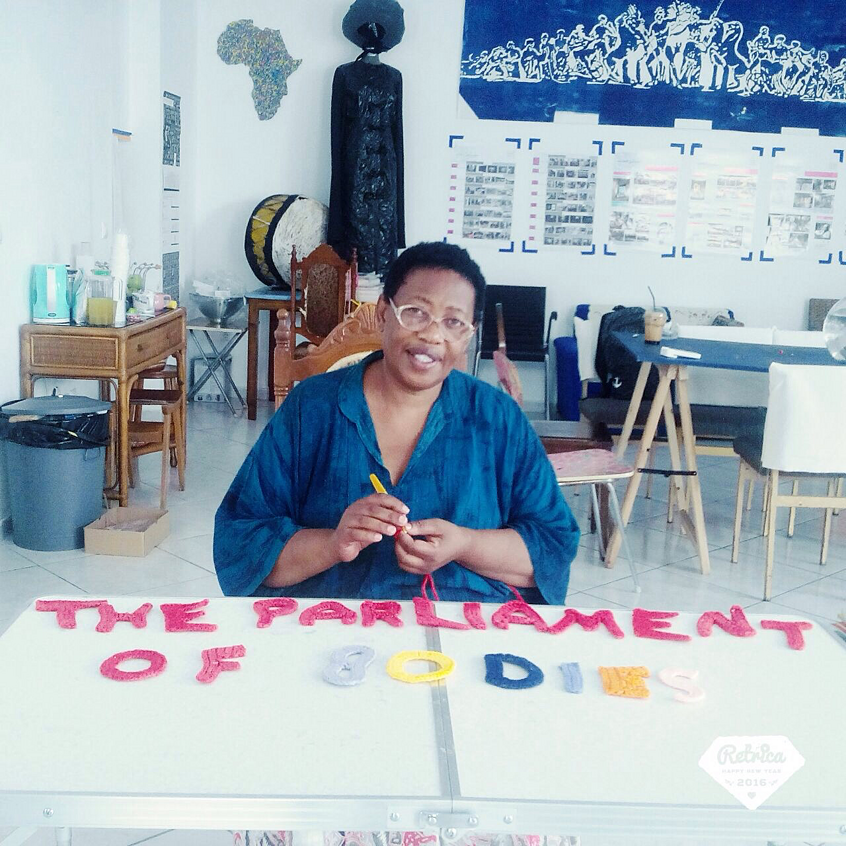
Beau Dick, Tsonoqua Mask (2016), acrylic paint, red cedar, horsehair, and graphite, 162.6 x 121.9 x 60.9 cm, photo: Stathis Mamalakis
Beau Dick was given the name “Walis Gwy Um,” which means “big, great whale” in the Kwak’wala language. His carvings tap into the supernatural, as though everything he made is invested with spirit. Beau was from a small Dzawada’enux village on an inlet on Canada’s northwest coast, which is known as Gwa’yi in the Kwakw’ala language and Kingcome Inlet in English. Gwa’yi is secluded—even now. The easiest way to get there is to travel by boat. This seclusion meant that the village became something of a refuge for Kwakwaka’wakw people during the potlatch ban (1885–1951). Removed from the gaze of colonial authorities, people were able to continue the wealth of ceremonies necessary to instill customary forms of governance, including the naming of Hereditary Chiefs, of which Beau was one. This was the same region that compelled the anthropologist Franz Boas to think that he had reached the very edge of European knowledge. Perhaps because of its remoteness, Gwa’yi was less affected than other places by colonial genocidal assimilationist policies towards Indigenous peoples. Because of this, Beau was immersed in tradition from a young age.
Carving and ceremony were a part of Beau’s life from the beginning, and so was his need to follow his own path. After moving to Vancouver to finish his studies, he infamously rebelled against the school’s rigid dress code by insisting that it was acceptable to wear a t-shirt rather than a button-down. Other students soon followed his lead. In the end, the school amended their policies. In 2013, more than three decades later, he would lead a movement together with twenty-one companions that galvanized the nation: Awalaskenis II, a journey from the West Coast of Canada to the seat of settler power: Parliament Hill in Ottawa. There, in front of federal policy makers and national media, Beau and his collaborators broke traditional copper shields as a means of calling out the conservative federal government’s broken treaties, assimilationist policies, and the ongoing degradation of rights for Indigenous peoples. The pieces of copper were then rolled up and left on the steps of Parliament as evidence of the act (a copper breaking can be undertaken to bring great shame upon another person, as well as an offer of peace and a gift). The government’s response was to send the pieces to a museum in British Columbia.
Like many people, I first came to know Beau through his masks. I remember that first one well: a massive Tsonoqua with her signature dark face, long unkempt hair, and pursed red lips. When we included it in the exhibition Sakahàn: International Art at the National Gallery of Canada in 2013—a large group show including over eighty Indigenous artists—it was singular and stopped people in their tracks. Tsonoqua is the cannibal woman of the woods, yet also one who can bring great wealth. For me, she felt alive. In March 2016, me and my colleague documenta 14 curator Monika Szewczyk travelled to Vancouver and Alert Bay to meet with Beau. He was already very far along in the process of thinking about what work he would propose for documenta 14. He was interested in the intersections between Kwakwaka’wakw governance systems and the origins of democracy in ancient Greece as well as ideas of citizenship. It was well-known that Beau had eschewed any official form of Canadian government ID as he did not recognize the legitimacy of the federal government to not only dictate his identity as a “status Indian,” but also as a Canadian. Beau was and remains Dzawada’enux. During our visit, this led to a long conversation about how he might envision his role in the exhibition.
Beau wanted to travel to Athens so that he could speak with people who have had to leave their homelands. For him, the loss of one’s homeland rendered culture, language, and tradition vulnerable. This was one of his greatest contributions as a leader—a Hereditary Chief—and as an artist: refiguring tradition as the site of experimentation, innovation, and change. Wayne Alfred, a renowned artist in his own right, relayed that when “Beau rose up, many of us rose up.” He was speaking of the community in Alert Bay—which became Beau’s adopted home—as well as everyone who was touched by his life. Beau rose up because he was fearless. His work as an artist, his role a father, and his leadership in his community knew no bounds. True to his nature, he was always sharing his knowledge, skills, stories, and songs, mentoring anyone with the time and the interest. Shortly before he passed away on March 27, he made one addition to the set of masks that are here in Athens for documenta 14. He placed an “action figure” made in his own image—complete with long grey hair, one of his signature hats, a button blanket robe, and cedar Hamat’sa ring on his neck—on the back of his mask of an orca whale. True to form, he was the one pulling the strings. One of the preparators who worked closely on the installation of his work remarked that this is likely where Beau is now, riding on the back of the whale.
The team of documenta 14 wishes to thank all those who made the collaboration with Beau possible, including Linnea Dick and Geraldine Dick, Chief Robert Joseph, Alan Hunt, Cole Speck, LaTiesha Fazakas, Sarah Macaulay, Bernadette Phan, Kerri-Lynne Dick, Scott Watson, Lorna Brown, Pamela Bevan, Alexis Nolie, Annette Wooff, Wayne Alfred, Ryan Speck, Corey Bulpitt, David Sonny Hanuse, Darren Alfred, Arthor Hawkins, Joshua Watts, Jay Bellis, Greg Fitch, Doreen Fitch, Stephanie Joseph, Chelah Howard, Gaven Konschuh, Manuel Piña, Steven Loft, and all those who helped in ways big and small.
Gila’kasla
Gunalchéesh (thank you).


